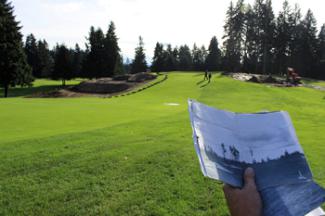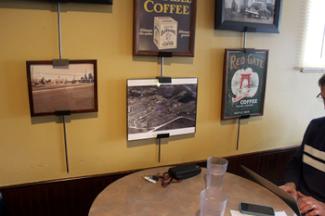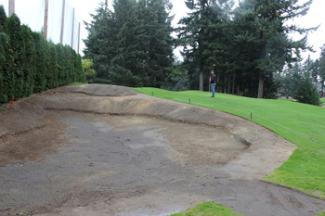Featured Golf News
Mending Macan

Mingay Used an Old Photograph of the 17th to Identify
the Position, Size & Shape of Macan's Original Bunkers.
In mid-October 2014 Jeff Mingay was sitting at one of the high tables against the back wall in Espresso Yourself, a small but popular coffee shop in Fircrest, Wash. Covering the wall was a montage of old posters advertising coffee brands from a bygone age - MiLady Red Gate, Cain's, Old Reliable - mixed with old photographs of the area that the café's owner, Bryce Kalland, had found at the Tacoma Public Library image archive.
Mingay was casually scouring the photos when he suddenly did a double-take. Right under his nose . . . well, a couple of feet to the right of it . . . was a large black-and-white aerial of Fircrest Golf Club, a particularly interesting photo for Mingay as he was in town to restore the course A.V. Macan had designed and built 91 years before.
"It was an amazing find," says Mingay whose reputation as a golf course architect continues to grow and who is now more or less established as the man members of Macan-designed courses look to when considering a renovation. "I'd never seen that photo before, so I quickly got a photocopy and now refer to it a lot."
A few months earlier, we ran a story (http://www.cybergolf.com/golf_news/victoria_gc_its_beautiful_best_after_prudent_restoration) about Mingay's work at Victoria GC on Vancouver Island where he had taken out a lot of unwanted flora to reveal views of the Strait of Georgia and Mount Baker the members didn't know they had, or at least rarely ever saw. Mingay, his friend and colleague George Waters and the club's maintenance crew had performed a handful of other tasks like renewing bunker sand and rebuilding a few bunkers, and the effect was profound.

The Fircrest Aerial from c. 1930 Hangs on the
Wall at Espresso Yourself
Fircrest wanted something similar - a careful, reasoned restoration that recaptured the visuals and challenges of the original design. It was a job Mingay had been hoping he'd get for several years. "I started studying Mr. Macan's work about 15 years ago, and quickly realized Fircrest was not only the best piece of ground he worked with but also his best layout," says Mingay. "It's also the best-preserved of his original designs. So, Fircrest represents the best opportunity to genuinely restore the best of his work."
Bringing up the subject of renovations and changes and restorations and alterations at a course that the members have been playing quite happily for 10, 20, 30 or even 40 years is a very delicate business. The course evolves slowly during that time and the folks who play it once a week or more can't possibly be aware of the tiny shifts and imperceptible changes that are happening constantly under their feet and above their heads. It's like watching a toddler grow. He doesn't look any bigger than he did yesterday of course, but see a photo of him from three years ago and the change becomes instantly apparent.
It's not an exaggeration therefore to suggest the prospective course renovator walks on egg shells. He must demonstrate a passion for the course, and the architect who designed it, while tempering that enthusiasm with a calm and composed expertise that says I am not about to turn your Macan original into a Mingay showcase, but rather quietly re-create the course your grandfather might have played nearly a century ago.
Mingay first addressed the club members at the annual general meeting in November 2013. The mood in the room, he says, was surprisingly positive. "You never know quite what to expect," he says. "I'm coming at it from one point of view while the members see it totally differently. But the board, management and members at Fircrest were very gracious, and I received a lot of very encouraging feedback from people who were obviously excited about the prospect of restoring Macan's holes."
Most importantly, Mingay says he felt the club trusted him.

Mingay Inspects the Shape of a Huge New Bunker
along the Left of the 3rd Green
Fircrest general manager Jeff Hilen confirms the trust and that the positive feeling Mingay had felt at the AGM was entirely genuine. "He really ignited the membership's excitement over the proposed project," Hilen says. "We'd known of Jeff's work and portfolio for years. We never had any apprehension in hiring him. He has such a sound sense of Macan's design philosophy. Having him here is as close to having Macan on-site as we could possibly get."
Six years ago, Fircrest superintendent John Alexander and his staff removed about 300 large firs from the course and the members soon began to appreciate the change in the quality of the turf, not to mention the enhanced views. "Not only is the health of the turf much improved," Alexander says, "but we could see Mount Rainier again. It was also a little easier to make a recovery shot in spots."
The tree removal remedied only part of the problem, however, if indeed the course's slow evolution could be seen as a problem. But the club invested heavily in a new irrigation system and maintenance shop, so any further changes had to be put on hold indefinitely.
With Mingay's pitch came a new sense of anticipation, however, and when he submitted his master plan identifying bunker renovations as the top priority - just as the club's prior consultant, the late John Harbottle, did three years before, the decision was taken to give Mingay the green light.
Planning happened in February of 2014 before Mingay returned in the first week of November and turned on the machines.
Over a period of several decades, bunker sand inevitably becomes dirty and contaminated, and more often than not bunkers get smaller. Some disappear altogether. A combination of factors is at play. Sometimes, an original bunker will become obsolete and the club just takes it out. More often, a club will have the superintendent take a bunker out in an effort to save money. Sand - transporting it to the course, and maintaining the bunkers it fills, is expensive and often time-consuming, so the fewer bunkers a club has the more money it saves and the more time its maintenance staff can deal with other areas of the course.
And then there is the strong-willed course committee chairman who doesn't like a particular bunker because it always seems to be on the end of his hook or slice. After a quiet word with the superintendent, the offending bunker disappears, or is made significantly smaller, before the members have any notion of what is happening.
Such was the case at Fircrest. "Some of the original hazards have been filled in," says Mingay, referring specifically to the imposing bunker complex Macan built short and left of the 17th green (and which can clearly be seen in the aerial photograph on the wall in Espresso Yourself) but which disappeared at some point. Mingay, along with his lead shaper Kip Kalbrenner - who renovated the bunkers at Sahalee prior to the '98 PGA Championship and is a well-known figure in Northwest golf circles - were busy restoring those bunkers when I visited the course recently. Mingay had a 1924 photo taken by Tacoma News Tribune photographer Chip Bowen that shows the 17th's original bunkers; when you watch Kalbrenner digging them anew it is easy to picture how great they are going to look and how good a hole the 17th will be again. You also have to wonder who had the nerve to take them out.
A large bunker will also be restored to the right of the third green. Other bunkers have been added at various stages - those that weren't part of Macan's original vision and which don't really come into play. They will be removed.
But the main task of the program is to rebuild existing bunkers that are staying but which have lost all semblance of their original style and character. Alexander says those bunkers have become too labor-intensive, and just don't function very well. "Because of the way the sand has been raked over the years, the back lips have built up to the point where it has become difficult for our older members to enter and exit the bunker," he says. "This build-up also causes many unfair lies. The bunkers don't drain very well and they also have a lot of rocks that migrate up through the soil."
The new bunkers, Alexander adds, will solve all these problems. "They will be lined, have first-class drainage and, of course, new sand," he says. "There will be more weed-eating and hand-mowing on the steeper grass slopes of some of the bunkers, but the labor savings will ultimately outweigh the added mowing." More importantly, to the members at least, is the fact these improved bunkers will look a whole lot better than they did, and be easier to get in and out of.
The greens also need work. "They have shrunk," says Mingay. "Old greens always do over time. They need to be brought out to their original parameters to restore some neat peripheral hole locations and also the right look and feel of a classic 1920s-era course."
And mowing lines need to be revised. New trees have been planted at various times, and existing trees have grown and changed shape. The nature and challenge of each hole has therefore changed, and not always in a good way. One of the beauties of Fircrest, says Mingay, is the land's natural contours, which are at their best when the turf is mown to fairway-height. "I'd like to see a lot more of the property mown down," says Mingay. "That would show off the remarkable contour throughout the course."
As for the actual design, one hole is of particular interest to Mingay. Unlike Charles Blair Macdonald, who designed National Golf Links of America on Long Island, N.Y., and numerous other great American courses, Macan didn't really go in for templates - holes modeled on, or direct copies of, existing holes. So you'll rarely see a Cape, Biarritz, Short, Punchbowl or Alps on a Macan course. On the far northern edge of the Fircrest property, however, he did find a chunk of land that screamed for a Redan hole. It became Fircrest's 16th, and what a hole it is . . . was . . . will be again.
The original Redan is the short 15th hole at North Berwick in Scotland, which got its name when an army officer, having returned home following the Crimean War, remarked that the shape of the hazards 30 yards short of the green put him in mind of the Russian fort at Sevastopol. The green on this hole is set diagonally to the line of attack running front-right to back-left, and a large bunker guards the front-left of the green. The ground short and right of the putting surface is raised slightly, meaning a low shot that pitches on the raised ground (known as a "kick-plate") and banks left onto the green and hopefully toward the flag, is the ideal way to play it.
Macdonald's Redan holes rarely featured hazards 30 yards short of the green that obscured the flag, but always mimicked the orientation of the green, the deep front bunker, and the raised ground short of the green that served to kick the ball towards the hole. Macan's Redan played slightly uphill and, though there were no front hazards well short of the green, the land up by where he put the green itself was absolutely perfect.
This hole, though, was a reverse Redan. Instead of running front-right to back-left, Macan's green ran front-left to back-right. It must have been a wonderful hole when the course opened in 1924, but sadly, its subtleties and challenge had become increasingly warped over the years as a stand of pines about 50 yards short and to the left of the green had grown tall, eliminating the chance of hitting the low, running left-to-right shot the hole rewarded. Instead, Fircrest members now had to go directly at the flag, taking away the fun of the kick-plate and watching the ball bounce right and roll toward the hole.
"We've removed those trees and are in the process of replacing them with a bunker," says Mingay. "The point of the hole is you can flirt with the new bunker and use the tilt of the fairway to direct the ball toward a pin cut on the right side of the green, behind the right-side bunker. This is a fun way to play golf."
Another Northwest Macan original Mingay is currently restoring is Overlake Golf & Country Club in the eastern Lake Washington city of Medina, a little to the north and west of Bellevue. Mingay began work there in 2010 alongside superintendent Scott Stambaugh and his assistant Cory Brown, who took over from Stambaugh nearly 18 months ago. The membership at Overlake was a little reluctant at first to dabble with their course, so Mingay created what general manager Marcus King calls a '"pilot hole" to give the members a flavor of what he had in mind. It has gone down well, says King, who now hopes the club is in a position to proceed with the entire plan.

The Bunkers are Lined with Sod. After a Month the
Grass is Killed and Removed. The Thatch Mat Remains &
Prevents Sand Contamination
That will consist of updating the club's Forest Vegetation Management plan and removing unnecessary trees, improving the drainage, renovating and reshaping the bunkers (giving them more Macan-esque grass faces as opposed to the current sand faces), and renovating the tee boxes while also adding a few more to increase the course's overall length.
The benefits will be numerous. "First, it will give us the opportunity to replace many worn-out features on the golf course such as bunkers and tees," says Brown. "It will also allow us to install a comprehensive drainage system which will remove the occasionally saturated turf conditions that have plagued Overlake since before Macan first stepped on the property." And finally, Brown adds, the restoration will give Overlake a classic, distinctive look and feel that will recapture the strategic elements Macan originally envisioned.
That's what Mingay does. As the members at Inglewood, Overlake and Broadmoor in and around Seattle - and now Fircrest near Tacoma - have discovered (and also Victoria and Kelowna in British Columbia), he has the knowledge, skill and desire to turn back the clock and make golf courses originally designed by Arthur Vernon Macan look and play as they once did.
As King says, Mingay "channels Macan." And that makes this Canadian a very valuable asset for golf in the Pacific Northwest.
Tony Dear is an Englishman living in Bellingham, Wash. In the early 1990s he was a member of the Liverpool University golf team which played its home matches at Royal Liverpool GC. Easy access to Hoylake made it extremely difficult for him to focus on Politics, his chosen major. After leaving Liverpool, he worked as a golf instructor at a club just south of London where he also made a futile attempt at becoming a 'player.' He moved into writing when it became abundantly clear he had no business playing the game for a living. A one-time golf correspondent of the New York Sun, Tony is a member of the Golf Writers Association of America, the Pacific Northwest Golf Media Association and the Golf Travel Writers Association. He is a multi-award winning journalist, and edits his own website at www.bellinghamgolfer.com.
Story Options
 |
Print this Story |
